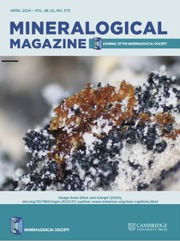Article contents
The migration and occupation of Li+ and Na+ in illite and montmorillonite during the heating process
Published online by Cambridge University Press: 25 April 2024
Abstract
The impact of temperature on the migration of cations within layers of clay minerals is of profound significance for the design and practical application of materials derived from clay minerals. This study focuses on Li+ and Na+ as representative cations, together with illite (Ilt) and montmorillonite (Mnt) as representative clay minerals. The study investigates the behaviour of cation migration and occupation within clay minerals across varying temperatures. A series of samples were prepared meticulously by immersing illite and montmorillonite in Li+ and Na+ solutions, subsequently subjecting them to different temperatures (unheated, 100, 150, 200, 250 and 300°C) for 24 h. Through the use of techniques such as X-ray diffraction (XRD), cation exchange capacity (CEC), Fourier-transform infrared spectroscopy (FTIR), magic angle rotating solid nuclear magnetic resonance spectroscopy (MAS NMR), and X-ray photoelectron spectroscopy (XPS), the study discerns structural transformations in illite and montmorillonite, and tracks the migration and occupation of Li+ and Na+. The findings reveal that following heating, Na+ and Li+ do not infiltrate the lattice of illite. For montmorillonite, Na+ also does not migrate into the montmorillonite lattice, however, in contrast, Li+ does exhibit migration into this lattice. Notably, the migration and occupation of interlayer Li+ within montmorillonite exhibit discernible temperature dependence. Specifically, upon reaching 150°C, interlayer Li+ migrate to ditrigonal cavities within the tetrahedral layers. As the temperature elevates to 200°C, Li+ further permeate vacant octahedral sites through the ditrigonal cavities, culminating in the formation of a localised trioctahedral structure.
Information
- Type
- Article
- Information
- Copyright
- Copyright © The Author(s), 2024. Published by Cambridge University Press on behalf of The Mineralogical Society of the United Kingdom and Ireland
Footnotes
Guest Editor: Qingze Chen
This paper is part of a thematic set on Nanominerals and mineral nanoparticles
References
- 1
- Cited by

